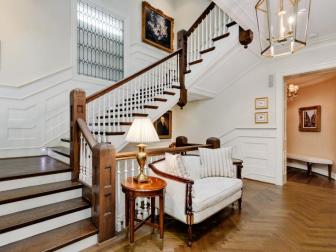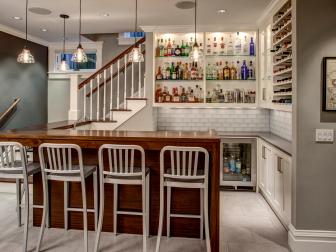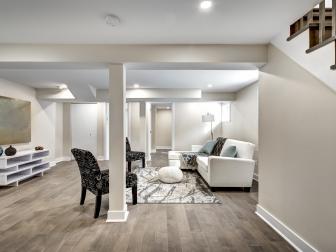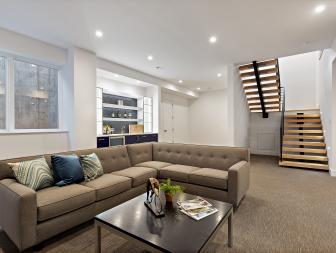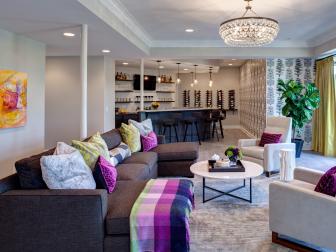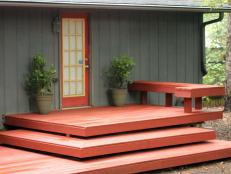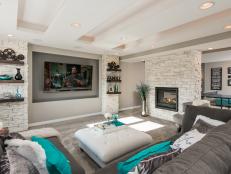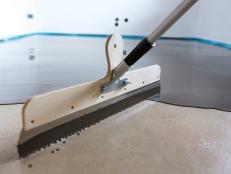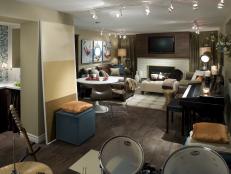How Much Does It Cost to Finish a Basement?
By increasing living space without adding square footage, a basement remodel can be a budget-friendly option if a home extension is not an option. Learn what goes into finishing a basement, who can help and what you might expect to pay.

Taking this underutilized space and transforming it for living is one of the better investments you can make in your home. The National Association of Realtors (NAR) Remodeling Impact Report estimated that 64% of basement finishing costs are recovered in the home's sale — one of the highest percentages in the 20 popular home improvement projects they looked at. Perhaps most importantly, homeowners were really satisfied they did it, giving basement finishing a joy score of 9.5 out of 10.
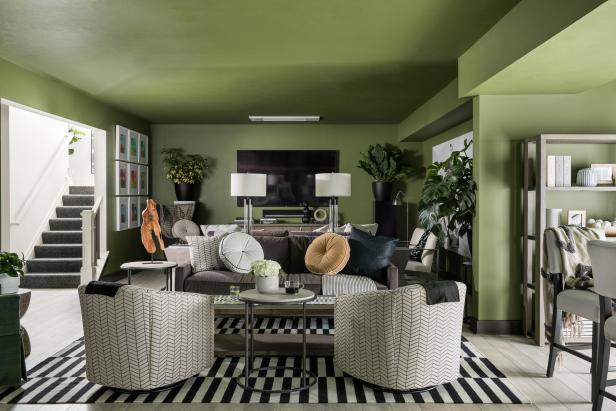
Robert Peterson, Rustic White Photography
So, basement finishing is worth doing but how much is it going to cost? Estimates vary widely — from less than $3,000 to more than $200,000 — which makes sense when you consider the differences in basement conditions and construction as well as the scope of design and finish possibilities. Let's examine the components of a basement finishing project, outlining the necessities for any finished basement, and then discuss specialty spaces that will up the wow factor — but also the price.
Primary Moisture Control
Finished walls and flooring provide some moisture protection, but only minor amounts of water vapor. Before finishing a basement, it's imperative to eliminate any existing moisture problems. Water issues can be as cheap and easy to solve as proper gutter maintenance and improving ventilation, or require pricier solutions like foundation repairs. You must address all water problems — no matter how icky — because you do not want to install lovely and expensive finishing work atop them. Visit our basement waterproofing guide to learn more about what you can do to eliminate basement moisture and when it's time to consult a professional.
Cost: Basement moisture remedies can run anywhere from $100 for minor gutter work to $15,000 for an exterior drain installation.
How to Fix Common Causes of Basement Water Problems
Waterproofing a basement can prevent structural damage, improve the air quality, lower utility bills and make a finished basement a possibility. Learn about common water problems in basements, what's involved to fix them and how much you might expect to pay.
Codes and Permits
Like any major home improvement project, basement finishing requires permits and is governed by strict building codes that regulate many aspects of the work including materials, individuals who can complete the work (licensing) and details of the layout and execution. The regulatory environment is pretty specific to locale, and in some communities, adding a basement apartment or kitchen is subject to zoning bylaws. Though it may be an expensive annoyance to find out about a zoning violation after construction, it would be even worse to find out when you're trying to sell your home. Familiarizing yourself with code requirements and zoning issues first can help you plan your design, manage your expectations and stay within your budget.
Cost: HomeAdvisor data shows that the average cost for a building permit for basement finishing is $1,200–$2,000, but it can be substantially higher since it's based on where you live and what's included in the finish.
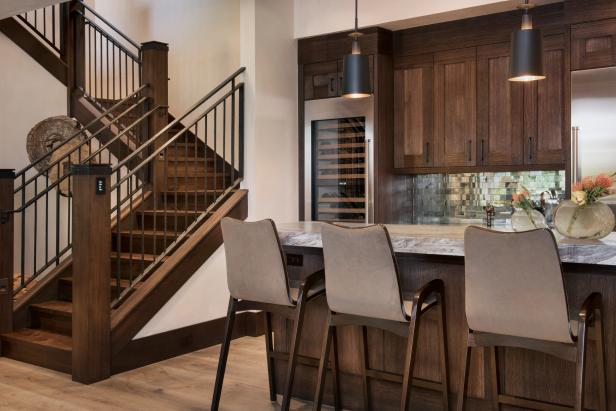
Slifer Smith & Frampton Real Estate, a member of Luxury Portfolio International
Safety
Hardwired smoke alarms are required in all finished basements. The amount depends on the size and layout of the space. The National Fire Protection Association (NFPA) also recommends installing a carbon monoxide alarm, which may not be required by code but is always wise if you have a gas appliance. Have a radon test performed if you haven't in a while (or ever), so you can remedy any problem discovered during the basement finishing process. The biggest construction-related safety issue to consider is egress. Every finished basement requires at least one emergency exit in the form of a door to the outside or, more commonly, an egress window — an adequately sized window that a person can climb out of — and its location does matter. Most municipalities want every bedroom to have its own egress. In a single-bedroom basement, one egress may fulfill the requirement for the entire basement, but it depends on where you live. In Chicago, for example, you cannot have the only egress within a space that locks so if the bedroom is the egress point, you cannot put a lock on the door. This brings up an important issue to remember: a basement window serves not only as an exit but is also for first-responder access. Aside from interior layout issues, the egress window requirement can be a significant obstacle to a finished basement design because one must also avoid utility lines, take into account property drainage issues and make sure the window will remain accessible inside and out, all of which limit location options. In an interview with Remodeling, Jason Weinstein, the owner of Budget Dry in Connecticut, suggests that for these reasons (and contrary to popular practice) finished basements should be designed from the outside in, not the inside out.
Cost: Adding an egress window is $3,000-$7,000 on average according to HomeGuide data, with much of that in the installation cost and this is not a job you want to tackle yourself. A walkout door could be similar to the window in cost or—depending on the level of excavation required—as much as $40,000.
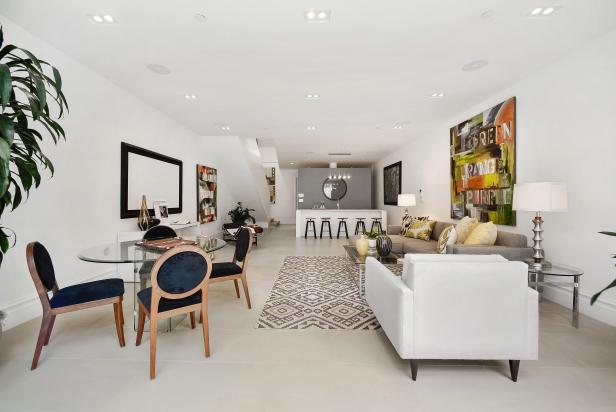
Paragon Real Estate Group, a member of Luxury Portfolio International
Stairs
Basement stairs are often bare-bones, unattractive and, unfortunately, not within code for a finished space. Upgrading the stairs to code may include modifying the rise and run, widening or changing steps to a solid-riser construction and adding handrails or a landing. You may alter the style altogether to better suit your new aesthetic. Designers like to open up the stairs if possible, adding scale and light to the space.
Cost: Creating new basement stairs costs $1,000-$3,000 on average, according to HomeGuide.
Staircase Know-How and Design Ideas 28 Photos
Planning a staircase update? Know your options and learn the lingo before you talk to a contractor or a designer.
Heating, Ventilation and Air Conditioning
Finished basements are required to have heating as well as return air, so Donald Prather, technical services manager for the Air Conditioning Contractors of America, recommends first contacting an HVAC professional to get a load calculation of your present system. This will help you decide whether to modify your existing furnace to include the new living area or add a supplemental one. If you'd rather not have the furnace as your Zoom background in your new home office, or your kids playing ring-around-the-water-heater in their rec room, you'll want to create a mechanical room to sequester major appliances. Such a room has its own code-determined space and ventilation requirements. Jamie Saer, project manager for FBC Remodel in Denver, further justifies the project: “You want to keep areas around your furnace and water heater free and clear of clutter and debris, otherwise it can become a fire hazard. We do this by building walls around this equipment to create a safe space for these units and minimize noise.”
Cost: HomeGuide estimates that HVAC work will run from a $1,800 minimum cost for modifying an existing system to $16,000 (high-end) for adding a new system.
Electrical, Gas and Plumbing
Finished basements require quite a few dedicated electrical circuits, depending on the number of rooms and appliances. If you're adding a gas appliance, you'll need to extend your gas line. Bathrooms, kitchens and laundry areas require plumbing — hot water, cold water and drainage. Project manager Jamie Saer says that you never want to assume that your desired plumbing will work in any existing system, so the first step is to map your drainage: "A lot of this can be figured out with a simple drain video, usually $150 or less. [It] will locate your drain lines and tell you how big and how deep they are.” Also, homes in which plumbing exits above the basement slab will require specialized equipment that could include a backflow valve — exactly as it sounds — and a special ejector pit, which Saer explains works like a sump pump for waste. Don't forget internet access: If you thought it was hard to get a signal in that upstairs back bedroom, your basement could even be worse.
Cost: HomeAdvisor averages $3,000 to $5,000 for electrical, $350 to $2,000 for plumbing and $900 to $4,000 to add a fireplace. Extending your network downstairs can add $200 to the price tag for a wireless signal booster on the low end to thousands if you're wiring a sizable space with high-quality ethernet.
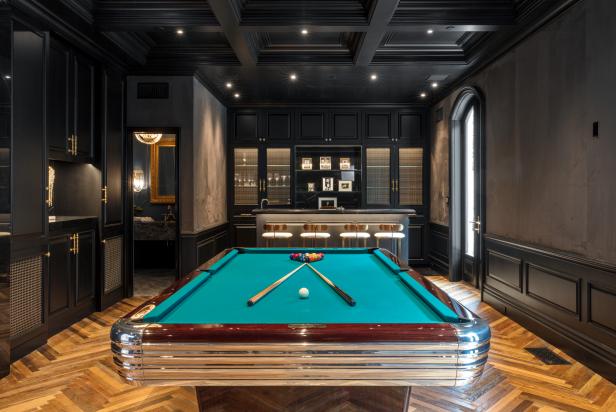
Hilton & Hyland, a member of Luxury Portfolio International
Lighting
Local code will dictate the number and location of light switches and receptacles and the number of dedicated circuits for lighting, depending on both room type and size. The code will also specify the minimum amount of light the finished basement area must have — often higher for bedrooms. Aside from these requirements, adequate lighting is crucial to excellent design; basements are no exception. Without access to the same natural light as upstairs, basements are dependent on a sufficient amount of artificial light to feel like a living space. Basement lighting can be a combination of recessed ceiling lights, task and statement lighting, and table and floor lamps. Light the perimeter to expand the space and strategically use lighting color (the Kelvin rating) to mimic daylight or cozy up the room.
Cost: Installing lighting will cost $100 to $650 per fixture, according to HomeGuide.
Basement Lighting Options and Ideas
Whether you’re planning a home theater with indirect mood lighting or a craft space with bright work lights, we've got answers to the most common questions about lighting the lower level of your home.
Finished Walls
A finished wall provides insulation for the basement space and hides electrical and plumbing lines. Basement perimeter walls are finished to code in a couple of ways: using traditional framing with insulation and drywall, or covering in prefabricated panels. Partition walls require framing. Drywall is a common surface option for finished walls, but shiplap, beadboard, barnwood and other cladding products can be used too. Exterior walls must meet minimum R-values, so leaving exposed one or more foundation walls is generally not an option, but Chicago designer McKinley Miller explains that she can create the look: "To make it look exposed we utilize thin brick, epoxy over the drywall or even textured wallpaper or paint.”
Cost: Framed walls with drywall and paint start at $30 a linear foot and go up in price for specialty products, according to HomeGuide.
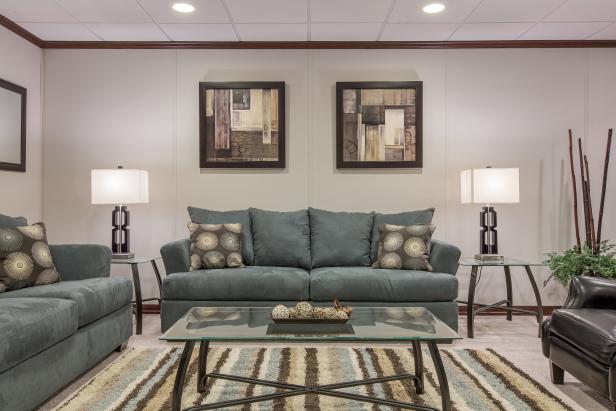
Matthew Metzger, Courtesy of Owens Corning
Ceiling
Basement ceilings often contain the pipes, ductwork and electrical lines that service the home. Minimum code-allowed ceiling height is often 7 feet and the ceiling can be drywalled or it can be suspended where a gridwork is installed with tiles that can be removed (a drop ceiling). Drop ceilings allow for easy access to utility stuff and leak repairs can be as inexpensive as replacing a tile, but they cut into your vertical height by 3 or more inches. Drywall offers a sleek and smooth finished look but makes upstairs leak repair expensive and prevents easy access to utility lines. A coffered or tray ceiling is a smart solution because it allows for height where you have it, and masks utility lines and ductwork with the framed portion. You could leave the ceiling plumbing and ductwork exposed and paint or clad it, but don't forget that ceilings are a prime place for sound insulation, important for a home theater or game room.
Cost: A drywall ceiling averages $2-$4 per square foot, according to HomeGuide. Decorative ceilings will be more.
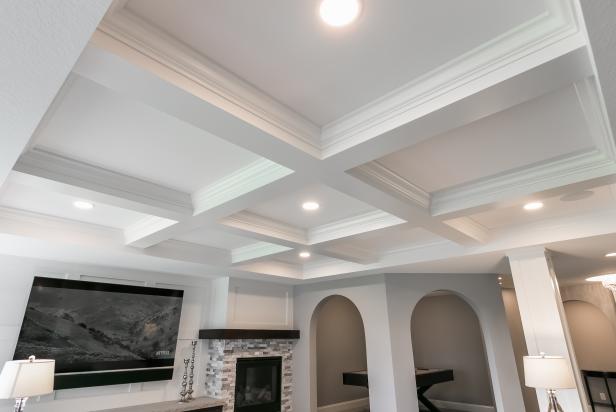
Jeffrey Bartol, courtesy of FBC Remodel
Flooring
The flooring portion of a finished basement may include rehabilitating the subfloor, placing underlayments (e.g. vapor barriers, insulation and padding) and then installing a finished floor and baseboards. Tile, vinyl, carpet, engineered hardwood and laminate are surface flooring choices you could consider downstairs, with some caveats. Simply finishing your concrete floor is an option too. If you are creating multiple basement spaces — even within a single room — it makes sense to consider them separately. FBC Remodel designers love to use tile in wet bar areas and bathrooms, but encourage homeowners not to choose tile for the entire basement floor because it can make the space cold. For cozy spaces like playrooms and home theaters, designers recommend carpet. Heated floors are a good strategy for warming a basement space.
Cost: Surface flooring starts at $2 per square foot, with carpet being the least expensive, and gets into the double digits for some hardworks and tile. Concrete finishing averages $3 to $15 per square foot, according to HomeGuide.
The Best Types of Basement Flooring and How Much They Cost
Explore today's choices for finished basement floors including luxury vinyl tile, hardwood, carpet, porcelain tile, specially dyed concrete and yes, even laminates.
Finish Work
Surface treatments are the most DIY-friendly portions of the basement finishing process. Many people opt for paint in the basement but for those who have humidity levels totally under control, wallpaper and other wallcoverings are options too. You may be inclined to choose a light palette for your wall colors, but don't give in to that temptation. Assertive color and pattern can really brighten basement areas, and dark colors are particularly appropriate for specialty spaces like home theaters, wine cellars, dens and game rooms.
Cost: Interior painting averages $1 to $3 per square foot, according to HomeGuide, with decorative finishes far more.
Specialty Spaces
With these fundamentals in mind, you can imagine all the possibilities for a basement space. For the specialty spaces below, we've included an average cost and some basement-specific considerations for construction.
- Bedroom: Adding a basement bedroom can cost as little as $3,000 to $12,000 according to HomeGuide, but meeting egress, ventilation and lighting requirements will up the cost. There may be a size minimum for your bedroom — Fairfax County, Virginia, for example, says 70 square feet with the shortest dimension at least 7 feet. If the home is on septic or supplied by a well, some jurisdictions want a health department stamp of approval. To be considered a bedroom for home resale purposes, basement bedrooms may have larger window requirements than minimum egress size, and require a closet.
- Bathroom: A basement bathroom can cost anywhere from $15,000 to $90,000 depending on whether it’s a powder room, half-bath or full, and how fancy you want to get. The bathroom requires a dedicated electrical circuit and GFCI outlets as well as plumbing that may require those aforementioned specialty drainage components. Save on plumbing installation by locating the bathroom near existing plumbing lines. Also, a bathroom without an operable window requires an externally ducted exhaust fan.
- Kitchen: A basement kitchen is similar in price to a main-level kitchen — $25,000 and up — way up. At a minimum, it will require plumbing (like the bathroom) and several electrical circuits to supply power to appliances, outlets and lighting. Externally ducted ventilation is a must, and if you install a gas range, you'll require a gas hookup. Wet bars or minimalist kitchenettes with just a sink, small fridge and microwave are substantially cheaper because they circumvent much of the mechanical cost.
- Apartment: Creating a basement apartment costs roughly $40,000 to $125,000, according to HomeAdvisor. That includes a kitchen or kitchenette, bathroom and laundry area — with the kitchen being the most expensive part of the construction. Apart from the individual room considerations, a rental apartment requires its own heating and cooling, electrical panel and water heater independent of the rest of the house. The waste line is the only shared item. The special permitting for rentals can also be very expensive.
- Home Theater: HomeAdvisor estimates that basement home theaters average $2,000 to $63,000 and FBC Remodel estimates its builds at $70,000 to $120,000, with the upper end representing a dedicated room with theater seating. Aside from the big screen, projector, sound system and cozy recliners or sofas, you'll need vast quantities of low-voltage wiring and insulation.
- Wine Cellar: A wine cellar could run between $5,000 to $20,000 depending on the finishing work, the size of the space and whether it's temperature controlled.
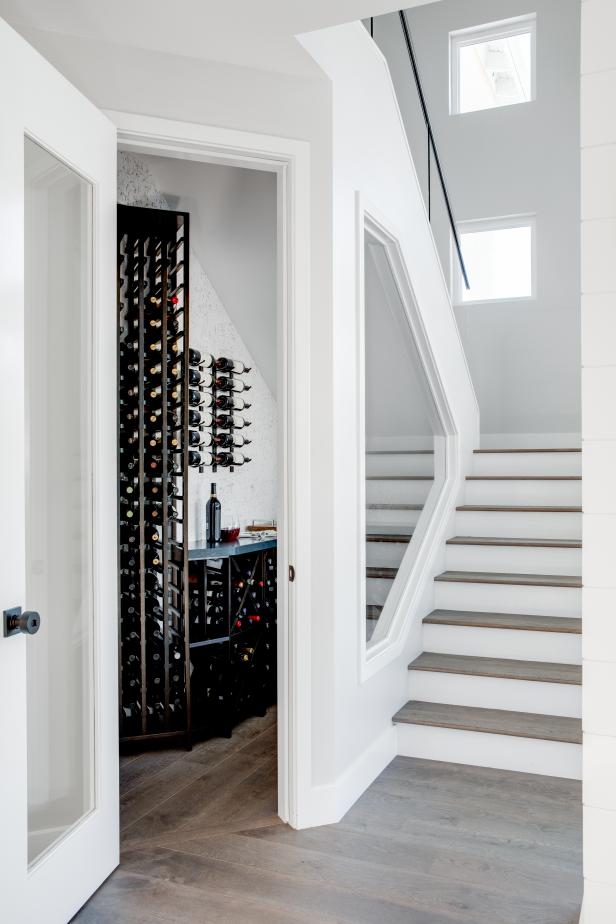
Chad Mellon
Who Can Help?
Now that you've decided to remodel the basement, who will help you cross the finish line? You have options.
Basement Contractors
If you have moisture problems, basement contractors will waterproof your space and then finish it for you in one go. If you have moisture problems, basement contractors will waterproof your space and then finish it for you in one go. HomeGuide data indicates you can expect to pay $50 to $150 per hour or 10-percent to 20-percent of construction costs for their help finishing a basement. If you're building a specialty space and need an architect, their rates average $100-$250 an hour. Timeframe: five weeks on average
Design-Build Firms
A step up from a basement contractor is a design-build firm employing a team approach — designers and trusted tradespeople who are overseen by a project manager to handle everything from conception through execution. Cost: You'll pay roughly 25 percent more for its services than a basement contractor, but in exchange, you get total customization, high-quality materials and a stress-free experience because of the efficient process. FBC Remodel is a deisgn-build firm with operations in Denver, Minneapolis and Chicago. Timeframe: six weeks to four months
Professionally Installed Basement Finishing Systems
The Owens Corning Basement Finishing System is a packaged product offering walls, ceiling and floor with limited customization that is professionally installed in record time. Depending on what part of the country you live in, it may be marketed as the Unlimited Basement Finishing System. The wall portion of this product is unique — all-in-one breathable wall panels with fiberglass-insulated cores that are removable for foundation inspection and maintenance. Between the wall panels and metal framing, the system is made entirely of mold-and-mildew-resistant materials. A drop ceiling is included and flooring options include laminate and carpet, but the installers will work with homeowners who have something different in mind. The system comes with a lifetime limited warranty, but water issues must be resolved before installation. Like contractors and design-build firms, the cost depends on the complexity of the basement space. Timeframe: a few weeks
DIY
The NAR Report found that nearly half of homeowners did at least a portion of their remodeling projects themselves, but the maze of code requirements that dictate who can do the pricier jobs, like plumbing and electrical, raises questions as to the extent of the cost savings. Painting and laying the floor yourself can save you quite a bit. FBC Remodel found that the primary drivers of cost in its builds are the layout and age of the basement, code compliance issues, electrical upgrades and appliances, and the inclusion of bathrooms, specialty rooms and features. Another place to save is by limiting the number of rooms. Conveniently, Zillow says homebuyers actually prefer open-floor plans in basements, and the choice of quality materials so the standard downstairs is in keeping with the rest of the home. Cost: Choosing professionals only for the complicated jobs can cut your basement finishing cost in half. Timeframe: Well, that's the other downside to doing it yourself: Will you get around to it?! FBC Remodel offers a Nearly Finished Basement that includes all the fundamentals — plumbing and electrical, heating and air, walls and ceilings — leaving the finish work of painting, flooring and cabinet installation to the homeowner. Though clients opt for the scaled-back package about 10% of the time, the company says it is frequently called back later to finish the job.









